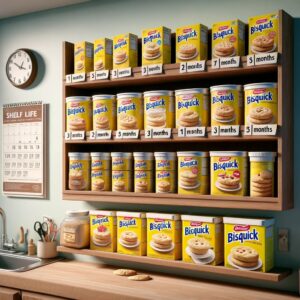Bisquick has long been a refuge for baking enthusiasts and busy parents alike. Its blue and yellow box is a familiar sight in many kitchens, passed down from one generation to the next. This popular baking mix simplifies the process of making muffins, biscuits, and bread, allowing anyone to feel like a baking expert with their baby steps into the world of baked goods.
However, even the most famous of kitchen staples like Bisquick have their limits. Many believe that Bisquick can last indefinitely due to its long shelf life, but that’s not entirely true. Recognizing when Bisquick has gone bad is crucial to ensure the quality and safety of your baked creations.
What Is Bisquick?
Bisquick, a staple in many kitchens, is more than just a food item. It’s a blend of flour, baking powder, and salt, with a flour-like consistency, crafted to improve the texture and quality of various dishes. Originating from the ingenuity of Carl Smith, a sales executive at General Mills, Bisquick’s recipe was formulated in the early 1930s.
The inspiration for Bisquick struck Carl during a memorable train ride from the East Coast to San Francisco, where he savored exceptional biscuits. Upon inquiring, he learned these were made by a cook using simple, wholesome ingredients. Captivated by this feat, Carl turned this idea into reality, leading to the birth of Bisquick – a true slice of culinary history.
Can Bisquick Go Bad?
It’s a common question: Can Bisquick go bad? Despite being shelf-stable, this popular cake mix isn’t immune to the ravages of time. Bisquick is formulated with long-lasting ingredients like flour and salt, which theoretically could last indefinitely under the right conditions. However, it’s not just about these stable components. The oil and leavening agents in Bisquick also play a crucial role. Over time, these can deteriorate, affecting the mix’s overall quality.
How Long Does Bisquick Last?
When it comes to Bisquick, a common pantry staple, understanding its shelf life is crucial. Freshly stored and unopened, a box of Bisquick can retain its quality for up to 2 years from its manufacturing date. However, once opened, this duration shortens significantly. If you keep your Bisquick well-sealed, it can last for about 4 months. This is a testament to the product’s versatility and shelf life.
But how can you tell if Bisquick is past its prime? The best-before date on the packaging is a good indicator. It’s important to note that unlike the expiration date, the best-before date is more about the quality and enjoyment of the food rather than its safety. As someone who frequently bakes, I always recommend checking the best-before date for an assurance of peak flavor.
Now, identifying signs of spoilage in Bisquick is another critical aspect. If you find any unusual odors, changes in texture, or visible mold, these are clear signs that the Bisquick is no longer suitable for consumption. Despite its long lifespan and durability, Bisquick isn’t impervious to spoilage, especially when not stored correctly.
For the safety and quality of the food you prepare, always inspect your Bisquick before using it, especially if it’s past its best-before date. Remember, the wonders of this versatile mix lie in its freshness. As a baking enthusiast, I can vouch for the importance of using fresh ingredients. Regularly inspecting your pantry items, including Bisquick, helps maintain the high standard of your dishes.
How to tell if Bisquick is bad?
When it comes to Bisquick, a popular baking mix, detecting spoilage is key to ensuring the safety and quality of your baked goods. The first thing to look for is a Clumpy Texture. Originally fine and powdery, Bisquick can become clumpy due to moisture exposure. This is a clear indicator that the spoilage process has begun. If you open your box and find the mix clumpy, it’s best to throw away the opened pack for safety purposes.
Identifying Mold and Bacterial Growth
Mold growth is another significant sign of spoilage. When inspecting your Bisquick, look for dark green, blue, or black spots. These are telltale signs that the dry mix has come into contact with moisture. Don’t try scraping off the affected part; it’s safer to discard the entire box. Similarly, Bad Smell indicates bacterial growth, especially a foul odor or an off smell. This can occur even in products with natural preservatives if they’ve been exposed to moisture and air.
The Problem with Bugs and Insects
Bugs and Insects in your Bisquick are not just unappealing but also a health concern. These pests can get into the mix if it’s not properly sealed, leading to potential contamination. If you encounter any insects, discard the mix entirely, as merely removing the bugs isn’t enough.
Ensuring Proper Storage
To prevent these issues, proper storage is crucial. Always ensure that your Bisquick is properly sealed and stored in a dry place. This minimizes the chance of moisture exposure and the entry of insects, thereby prolonging the shelf life of the product.
When to Say Farewell to Bisquick
If your Bisquick shows any of these signs – clumpy texture, mold growth, bad smell, or insect presence – it’s time to say farewell. Using such a product can compromise the quality and safety of your dishes.
The Importance of Regular Checks
It’s recommended to inspect your Bisquick regularly, especially if it’s been stored for an extended period. Regular checks can help in early detection of any spoilage signs.
By being vigilant about these signs of spoilage, you can ensure the safety and quality of your baking endeavors with Bisquick.
How long is Bisquick Good for After Expiration Date?
Bisquick, a blend of all-purpose flour, leavening, salt, and oil, is a pantry staple for many. Known for its versatility in making delicious pancakes and biscuits, its longevity is often a topic of interest. When sealed and stored in a cool, dry, and insulated space, Bisquick’s oil component can last up to 10 years. However, once opened, its lifespan reduces to 2 to three years in a similar environment. This shelf life is due to the formulated mixture of ingredients, which are less prone to spoil quickly.
Identifying when Bisquick has gone bad involves observing changes in its physical properties. A clumpy or deteriorated texture and any off odors are clear indicators. The leavening agent, crucial for creating those fluffy, bubbly textures in pancakes, loses its efficacy over time. This deterioration reduces its ability to trigger fermentation, thus affecting the final product’s quality.
Safe Consumption of Bisquick Post Expiry
While the oil in Bisquick may remain stable, it’s important to consider the other ingredients. The natural flour and leavening can lose their effectiveness, leading to subpar baking results. Always inspect the mixture for spoilage signs before using.
For safety reasons, if there are any doubts about its quality, especially in an opened package, it’s safer to discard the mix. Remember, the absorption of moisture or contamination can compromise the product, making it unsuitable for those delightful butter and syrup-laden breakfast treats.
How to Store Bisquick Last Longer?
Storing Bisquick correctly is essential for prolonging its shelf life and ensuring its best quality for your baking needs. Here are some expert tips to help you keep Bisquick fresh and usable for longer.
Choose the Right Location
The key to extending the shelf life of Bisquick lies in its storage location. Store it in a cool, dark place like your pantry or a cabinet that’s far from heat sources like the stove and oven, as well as away from direct light from kitchen windows.
Seal the Deal for Opened Boxes
Once you’ve opened a box of Bisquick, it’s crucial to protect its contents from light, air, and moisture. For the bare minimum, fold the pack’s ends and use a clip or tape to seal it. But for optimal freshness, transfer the opened pack into an airtight container.
Consider the Climate
In hot climates, it’s advisable to refrigerate Bisquick to prevent moisture buildup. This helps in keeping the mix dry and free from clumping.
Embrace Proper Storage Techniques
Proper storage techniques, as recommended by food scientists and baking experts from the Culinary Institute, include tightly sealing the package to prevent exposure to air and moisture. This helps to extend the shelf life of the mix.
Freezing Is an Option
Although not necessary due to its already long shelf life, freezing Bisquick is an option. However, this increases the risk of moisture exposure. If you choose to freeze, divide the mix into single servings, double wrap them for extra protection, and label the container with the storage date. Remember to thaw it overnight in the refrigerator or leave it at room temperature before use.
Regular Checks
Regularly check the quality of your Bisquick, especially if it’s been stored for an extended period. This is crucial to prevent spoilage and ensure the mix is fit for use.
Be Mindful of Shelf Life
Even with the best storage practices, remember that Bisquick’s shelf life will be shorter once opened. Keep an eye on the expiration date and quality indicators such as texture and smell.
Avoid Contamination
Always use clean, dry utensils when handling Bisquick to prevent contamination. This helps in maintaining the quality of the mix.
Secure the Environment
Ensure the storage environment is clean, dry, and well-insulated. This helps in keeping the mix safe from environmental factors that can cause spoilage.
Light and Air: The Enemies
Light and air are the main culprits behind the deterioration of dry mixes like Bisquick. Keep the mix in an environment that minimizes their impact.
Utilize Freezer-Safe Containers
If freezing, use freezer-safe containers or resealable bags to protect the Bisquick. This prevents freezer burn and moisture damage.
Follow Expert Recommendations
Following recommendations from experts in food storage can help in maximizing the shelf life and quality of Bisquick, ensuring you always have a fresh supply for your baking endeavors.
Conclusion
Determining if your Bisquick has gone bad is a straightforward process that hinges on observing key signs like clumpy texture, off smells, and the presence of mold or pests. To extend its shelf life and maintain its quality, proper storage techniques are crucial, ranging from keeping the mix in a cool, dark, and dry place to sealing opened packages effectively.
By following these simple yet effective guidelines, you can ensure that your Bisquick remains fresh and safe for use, letting you continue to create delicious, fluffy pancakes and biscuits whenever the craving strikes.
Frequently Asked Questions
Can you freeze Bisquick?
Yes, you can freeze Bisquick. Freezing can extend its shelf life, though it’s important to store it properly in freezer-safe containers or resealable bags to prevent moisture exposure.
How to defrost/thaw Bisquick?
To defrost Bisquick, transfer it from the freezer to the refrigerator and let it thaw overnight. Alternatively, you can leave it at room temperature for a few hours until it’s completely thawed.
How long is Bisquick good once opened?
Once opened, Bisquick can last for about 2 to 3 years if stored properly in a cool, dry place and in an airtight container to protect it from moisture and air exposure.
Is Bisquick good for long-term survival storage?
Yes, Bisquick is suitable for long-term survival storage due to its extended shelf life. When stored correctly in a cool, dry, and dark environment, it can remain usable for years.
How do you fix old Bisquick?
If old Bisquick hasn’t shown signs of spoilage but seems less effective, try adding fresh baking powder to revive its leavening ability. However, if it shows signs of spoilage, it’s best to discard it.
Can you use outdated biscuit mix?
You can use an outdated biscuit mix like Bisquick as long as it doesn’t have any signs of spoilage, such as mold, bad smell, or clumps. Always check the quality before using it.
Should you refrigerate Bisquick?
Refrigerating Bisquick is optional and usually not necessary. However, in hot and humid climates, refrigerating can help prevent moisture buildup, extending its shelf life.

